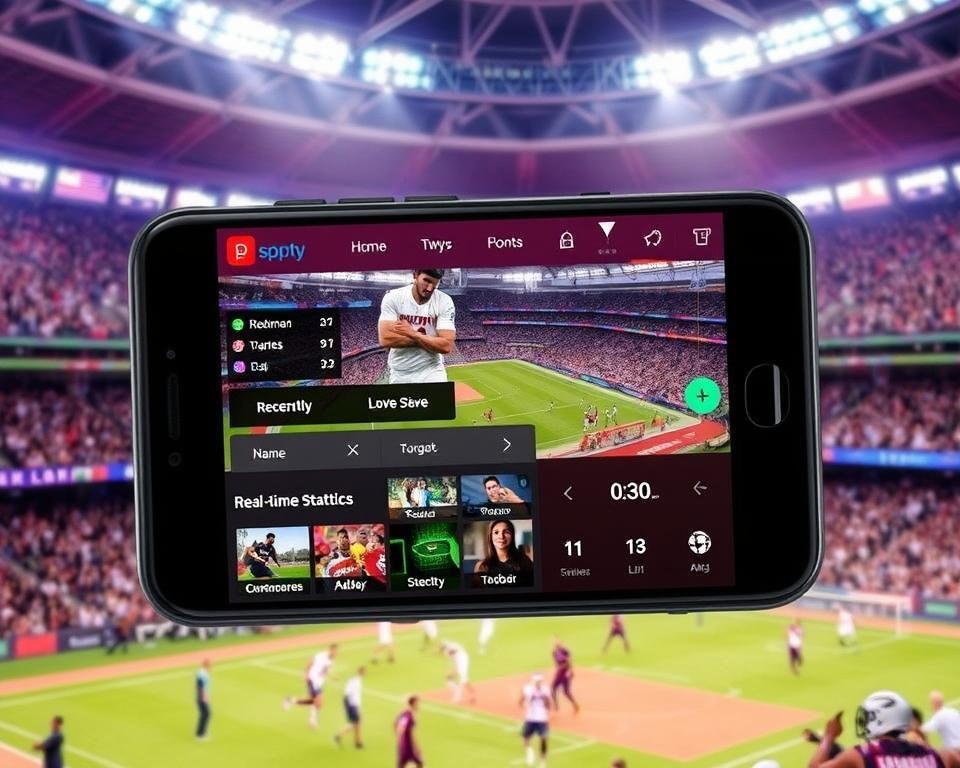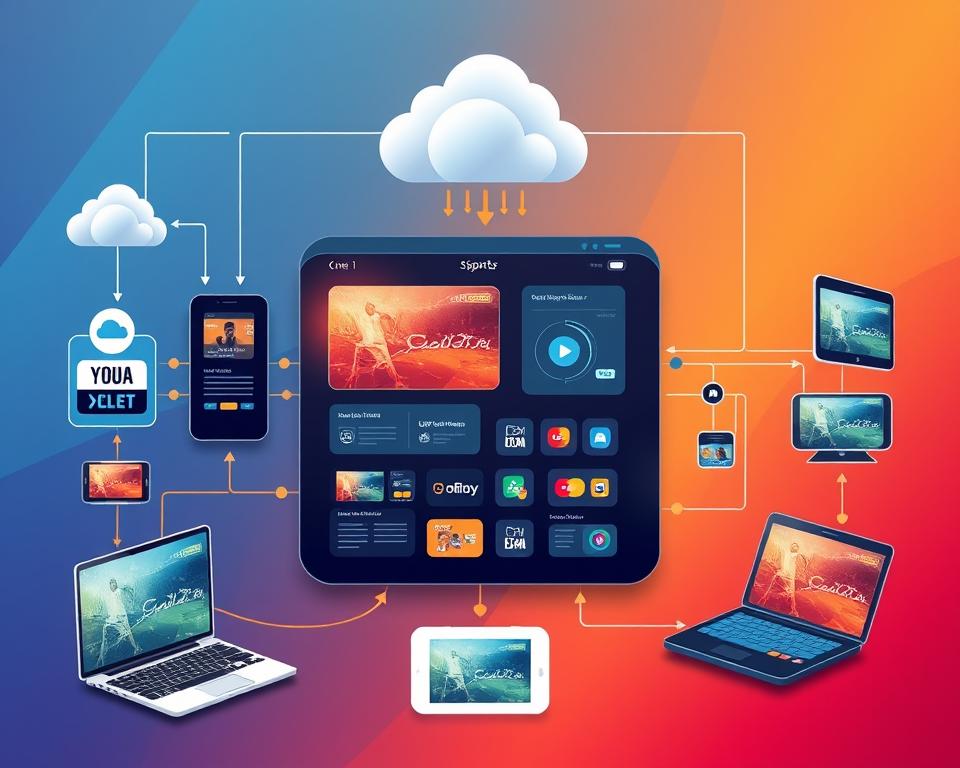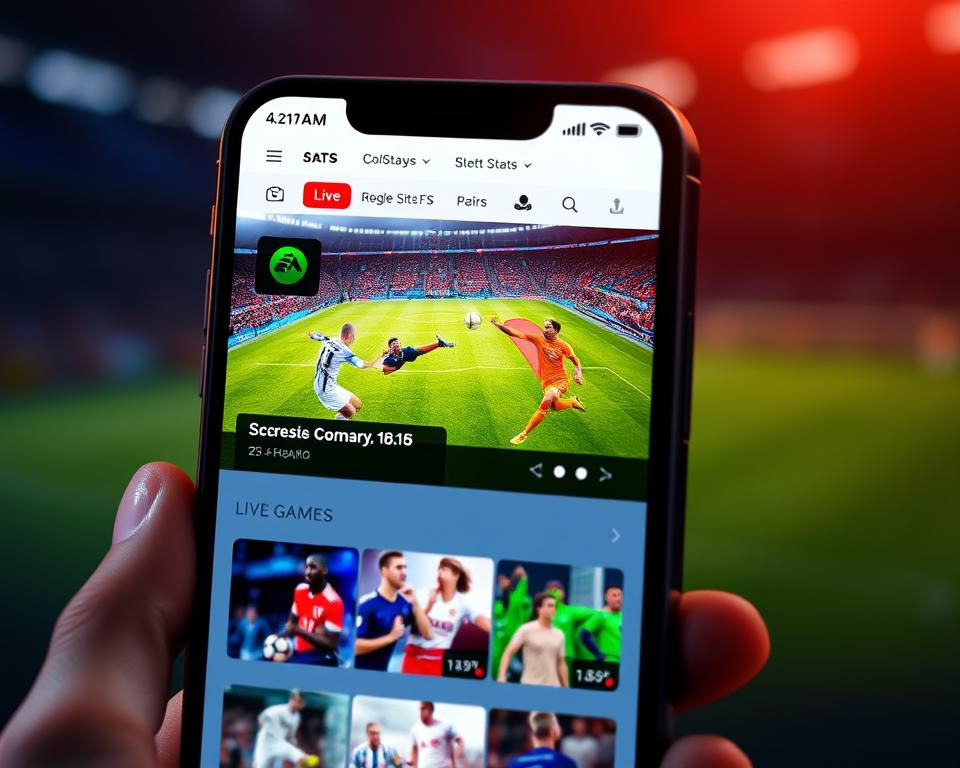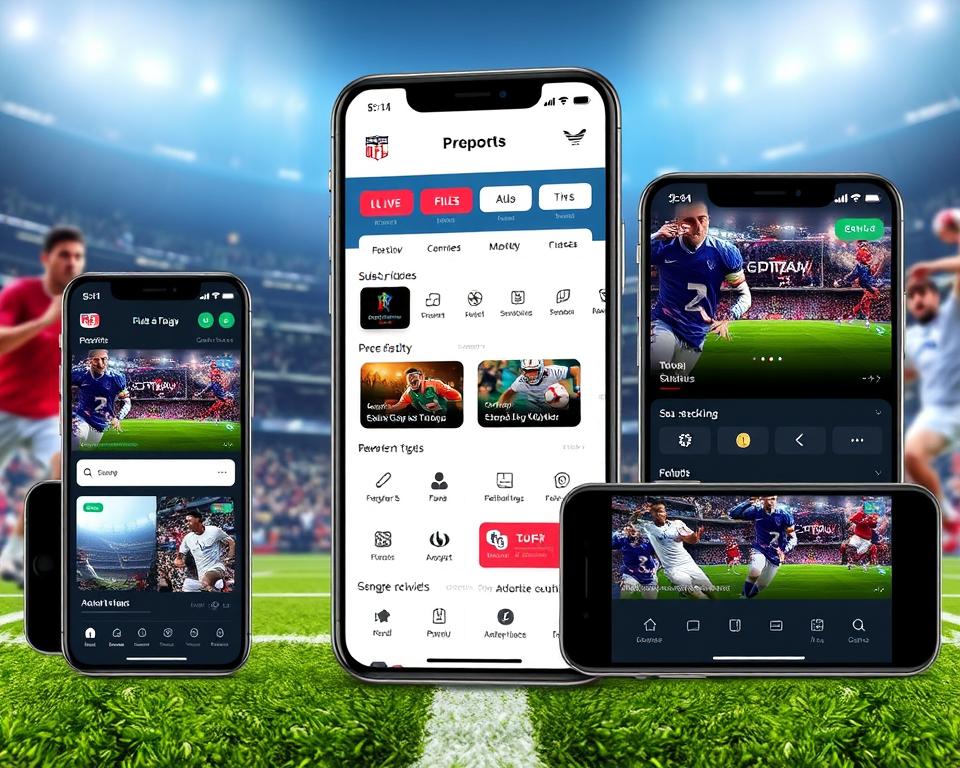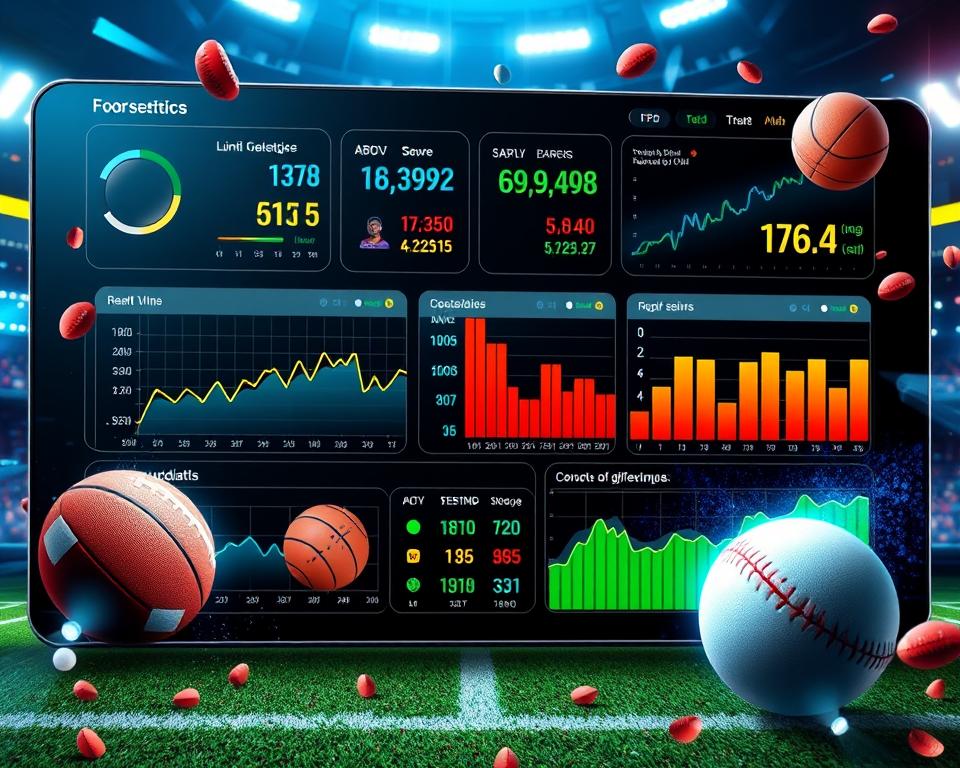In today’s world, people want to watch live sports more than ever. Fans want to see their favorite games and events as they happen. The sports media industry is changing fast, with sports streaming apps playing a big role in how we watch sports.
To make a great sports streaming app, you need to know the market, what users like, and the tech behind it.
This guide will cover everything you need to know to create a sports streaming app. We’ll talk about the market, key features, technical needs, and how to make money. We’ll show you how to build a top-notch sports streaming platform.
Table of Contents
Key Takeaways
- Understand the current sports streaming market and the growth potential
- Identify the essential features that drive user engagement and loyalty
- Explore the technical infrastructure and development stack required for a robust sports streaming app
- Implement live streaming functionality with low-latency and high-quality video
- Develop effective monetization strategies, including subscription models and advertising integration
Understanding the Sports Streaming App Market Landscape
The sports streaming industry has grown a lot in recent years. This growth is thanks to the rise of OTT platforms and people wanting on-demand content. The market is competitive, with big players trying to get more of the market share.
Current Market Size and Growth Projections
The global sports streaming market was worth $36 billion in 2021. It’s expected to grow at a 12.2% CAGR from 2022 to 2030. This growth is due to more smart devices, fast internet, and a desire for live sports.
Leading Sports Streaming Platforms Analysis
| Platform | Key Features | Strengths | Weaknesses |
|---|---|---|---|
| ESPN+ | Wide range of live sports, on-demand content, and original programming | Strong brand recognition, extensive sports rights partnerships | Limited international availability, higher subscription cost |
| DAZN | Live streaming of premium sports events, on-demand content, and original shows | Global reach, competitive pricing, and diverse sports offerings | Relatively newer platform, limited brand awareness in some markets |
| FuboTV | Live TV streaming with a focus on sports, news, and entertainment channels | Comprehensive sports coverage, innovative features like multi-view and cloud DVR | Higher subscription cost compared to some competitors |
Key Market Opportunities and Challenges
- Opportunities in niche sports and regional markets: The growing interest in niche sports, such as cricket, soccer, and esports, presents a significant opportunity for sports streaming platforms to cater to underserved audiences.
- Challenges in content rights acquisition: Securing exclusive sports broadcasting rights remains a significant challenge for streaming platforms, as major sports leagues and organizations compete to maximize their revenue.
- User retention and engagement: Retaining users and keeping them engaged with the platform is crucial for sports streaming providers, as the market becomes increasingly competitive.
The sports streaming market keeps changing, with both chances and hurdles for platforms. Knowing the market, key players, and trends is key for success in this field.
Essential Features for a Sports Streaming Application
Building a top sports streaming app needs key features. These include live streaming, personalized content, and more. They help keep users coming back for more.
Live, real-time sports coverage is a must. This means low-latency streaming and support for many devices. A smooth experience keeps users happy and loyal.
Personalizing content is also key. It means showing users games and highlights they’ll like. This makes users more engaged and loyal, helping your app grow.
- Intuitive navigation and user-friendly interface design
- Multi-device compatibility for seamless cross-platform viewing
- In-app chat and social sharing features to foster a sense of community
- Real-time score updates and live statistics to enhance the viewing experience
- Comprehensive content library with on-demand access to past games and highlights
For a great user experience design, focus on what sports fans want today. Add these features to make your app stand out in the market.
“The key to a successful sports streaming app is to make the user experience as seamless and immersive as possible, while also catering to the unique needs and interests of sports enthusiasts.”
Technical Requirements and Development Stack
Building a strong sports streaming app needs a good technical stack. This ensures smooth performance, growth, and a great user experience. Each part, from the backend to the frontend and databases, is key to the app’s architecture.
Backend Infrastructure Requirements
The app’s backend must handle lots of real-time data. This includes live streams, game stats, and user actions. A scalable server setup, often on cloud platforms like AWS or Google Cloud, is vital. These clouds offer auto-scaling, load balancing, and CDNs for fast, reliable streaming.
Frontend Technologies Selection
The app’s frontend is where users interact. The tech choice here greatly affects the user experience. Cross-platform frameworks like React Native or Flutter are popular. They make apps feel native on both iOS and Android, saving on development and upkeep costs.
Database Management Solutions
Good data management is essential for the app. It must handle lots of user info, game stats, and content details. Strong databases like MongoDB for NoSQL or PostgreSQL for relational data are needed. They ensure the app’s data-driven features work well.
| Component | Recommended Technologies |
|---|---|
| Backend Infrastructure | AWS, Google Cloud, Scalable Server Infrastructure, Content Delivery Networks (CDNs) |
| Frontend Frameworks | React Native, Flutter |
| Database Solutions | MongoDB, PostgreSQL |
Choosing the right tech stack is crucial for a sports streaming app. It leads to a scalable, fast, and user-friendly platform. This ensures sports fans get the best viewing experience.
How to Build a Sports Streaming App for Real-Time Game Coverage
Creating a top sports streaming app needs a solid app development process. First, do deep market research. This helps you know what users like, who they are, and what others offer. It guides you to add key features that sports fans really want.
Then, work on the sports app design. Make the app easy to use with live games, scores, and fun features. Use design that puts the user first to make sure it works well on all devices.
The real-time streaming implementation is key. Use the newest tech for video, content delivery networks, and fast streaming. This ensures your app works smoothly and looks great.
Use an agile method to develop the app. Break it into parts, test each bit, and keep improving. Make sure to test it well to catch and fix any problems before it’s out.
By sticking to this app development process, you can make a sports app that’s all about live games, great looks, and fun. This will help you get and keep users in the busy sports streaming world.
| Key Considerations for Sports Streaming App Development | Description |
|---|---|
| Market Research | Analyze user preferences, target audience, and competitive landscape |
| Feature Prioritization | Identify and focus on essential features that cater to sports fans |
| User Interface Design | Craft an intuitive and visually appealing user experience |
| Real-Time Streaming | Implement robust video encoding, CDN integration, and low-latency protocols |
| Agile Development | Follow an iterative, test-driven approach to ensure a high-quality app |
“Building a successful sports streaming app is all about understanding your target audience and delivering a seamless, real-time viewing experience that keeps them engaged and coming back.”
Implementing Live Streaming Functionality
Creating a smooth live video streaming experience is key for sports apps. Developers face challenges like video encoding, content delivery, and low-latency protocols. These must be overcome to ensure a top-notch streaming service.
Video Encoding and Transcoding
Good video encoding is the base for quality live streaming. Sports apps should use advanced encoding like H.264 or VP9. This improves video quality and saves bandwidth. Transcoding helps create different bitrate versions for better streaming on various devices and networks.
Content Delivery Network Integration
Using a content delivery network (CDN) is vital for streaming live video globally with low latency. CDNs store video on servers near users, cutting down on data travel time. This makes streaming faster and better. A CDN also helps handle sudden increases in viewers during live events.
Low-Latency Streaming Protocols
For live sports, low latency is essential for a real-time feel. Protocols like WebRTC offer sub-second latency. This makes the app and live event sync seamlessly. Low-latency protocols ensure users get updates and score changes quickly.
By tackling these technical needs, developers can make a live streaming platform that sports fans love. It offers an immersive and engaging experience.
User Authentication and Profile Management
Creating a top sports streaming app needs strong user authentication and easy profile management. These features make the app more secure and personal for users.
Secure login systems are key for user authentication. You can use OAuth for easy social media login or two-factor authentication for extra security. Offering different login options makes it easier for users to start using the app.
Profile customization is also vital for sports streaming apps. Users should be able to make their profiles their own by choosing favorite teams and sports. This makes the app more engaging and helps it show content that fits each user’s interests.
| Feature | Benefit |
|---|---|
| Secure Login Systems | Ensures the safety of user data and prevents unauthorized access |
| Profile Customization | Enhances user engagement and delivers personalized content |
By focusing on user authentication and profile management, app developers can make a safe and personal platform. This platform meets the unique needs and preferences of its users.
“Effective user authentication and profile management are the cornerstones of a successful sports streaming application.”
Monetization Strategies and Payment Integration
Creating a successful sports streaming app needs a good monetization plan. Free access can draw in many users, but it’s key to mix different ways to make money. This includes subscription models and in-app ads, which help sports apps earn steady income.
Subscription Models Design
Subscription models are big in streaming now. Sports apps can have different plans for various budgets and preferences. There’s a free plan with some content, and paid plans for more, like live games and replays.
Free trials can also help turn users into paid subscribers. This makes it easy for them to start paying.
Payment Gateway Implementation
It’s important to have secure and easy payment options. Sports apps should work with trusted payment processors. These should make payments smooth, support many payment types, and keep data safe.
Having a simple payment process can make users happier and more likely to pay.
Advertisement Integration Options
Ads in apps are another way to make money. Sports apps can use ads like pre-rolls and banners. This way, they can earn without annoying users.
Using data to target ads can make them more relevant and interesting to viewers.
| Monetization Strategy | Key Considerations | Potential Revenue Impact |
|---|---|---|
| Subscription Models | – Tiered pricing plans – Free trial offers – Exclusivity of content |
High, with recurring revenue |
| Payment Gateways | – Secure transactions – Multiple payment options – Smooth user experience |
Moderate, depending on conversion rates |
| In-App Advertising | – Targeted ad placements – Programmatic advertising – Minimizing user disruption |
Moderate to high, based on ad revenue |
By choosing the right mix of monetization strategies, sports streaming apps can boost their earnings. This ensures they stay financially stable over time.
Real-Time Statistics and Score Updates
Fans love live sports statistics and updates to make watching sports better. A sports app that shows live sports statistics and real-time score updates is key to keeping fans interested.
At the heart of this is data integration from top sports data providers. Your app can get and show the latest stats, scores, and big moments by connecting securely with these services.
- Make sure your app’s scoreboard updates automatically. This way, users always see the latest scores and game data.
- Use interactive stats and infographics to give fans a closer look at player and team performance.
- Provide alerts and notifications for big events like game-winning shots or record-breaking plays. This keeps fans in the loop.
| Feature | Description | Impact |
|---|---|---|
| Live Statistics Display | Integrate real-time sports data into your streams for a better viewing experience. | Boosts engagement, keeps users interested, and offers insights for sports fans. |
| Interactive Stat Overlays | Create dynamic overlays for in-depth player and team stats. | Increases fan interaction, sparks discussions, and makes your app stand out. |
| Customizable Alerts | Send personalized notifications for key events, so users stay updated. | Helps keep users coming back, builds a loyal fan base, and connects fans with their favorite teams. |
By combining live sports stats, real-time score updates, and data insights, your app becomes essential for sports fans. It sets you apart and builds a dedicated fan base.
Content Management System Integration
In the world of sports streaming, a good content management system (CMS) is key. It helps organize and schedule sports content smoothly. A well-designed CMS lets sports streaming platforms manage their media well, schedule content easily, and give users a great experience.
Media Asset Management
Good media asset management is the base of a great sports streaming app. A CMS helps sports streaming platforms keep their video content, highlight reels, and more in one place. This makes it easy to store, find, and share content. It lets content teams focus on making sports content that grabs viewers’ attention.
Content Scheduling Features
A strong CMS also boosts a sports streaming platform’s content scheduling abilities. It offers tools like automated programming, live event management, and customizable calendars. This ensures content is shown to viewers when it matters most, boosting engagement and viewership.
With a flexible CMS, sports streaming platforms can handle their sports content better. They can organize their media assets well and schedule content automatically. This leads to a smooth and exciting experience for their audience.
Mobile App Performance Optimization
The sports streaming market is growing fast. Making sure mobile apps work well is key for a great viewing experience. App performance tuning, mobile optimization, and streaming quality management are important. They help your app run smoothly, even when the network is slow.
Managing resources well is a big part of mobile optimization. This means using memory wisely, cutting down on background tasks, and optimizing images and videos. Caching helps too, making the app faster by reducing the need for constant network checks.
- Use adaptive bitrate streaming to adjust video quality based on the user’s network. This ensures a smooth and high-quality stream.
- CDNs help by placing media assets near the user. This cuts down on latency and boosts streaming performance.
- Make the app start up faster by preloading important resources and reducing initial network requests.
By focusing on app performance tuning, mobile optimization, and streaming quality management, developers can make sports streaming apps better. This leads to happier users and more engagement.
“The key to a successful sports streaming app is ensuring that the user experience is flawless, no matter the device or network conditions.”
Security Measures and Compliance Requirements
Sports streaming apps are getting more popular. It’s important to have strong security and follow data protection rules. This keeps the content and user data safe, which is key for keeping users’ trust.
DRM Implementation
Using a good Digital Rights Management (DRM) system is vital for sports streaming apps. DRM helps keep content safe by stopping unauthorized access. It makes sure only the right people can watch the content. This helps fight piracy and keeps the app’s content safe.
Data Protection Standards
Following data protection laws like GDPR and CCPA is a must for sports streaming apps. These laws set rules for handling user data. They help keep personal info safe. Following these laws helps avoid legal trouble and keeps users’ trust.
- Implement robust DRM solutions to secure content and prevent unauthorized access
- Comply with data protection regulations like GDPR and CCPA to safeguard user privacy
- Continuously monitor and update security measures to stay ahead of evolving threats
By focusing on security and following rules, sports streaming apps can keep their content safe. This helps keep users happy and ensures a safe experience for everyone.
Testing and Quality Assurance Processes
Creating a top sports streaming app needs careful testing and quality checks. Developers must use app testing methodologies and quality assurance (QA) methods made for streaming apps. This ensures users have a smooth experience.
For QA for streaming apps, performance testing is key. It checks how the app works under different network conditions. This includes changes in bandwidth, latency, and jitter. It’s vital for a top-notch streaming experience.
Through performance testing, developers find and fix problems. This makes sure the app can handle live sports without issues.
- Functional testing: Checks if the app’s main features work right. This includes video, live scores, and logging in.
- Compatibility testing: Sees how the app works on different devices and networks. It finds and fixes problems.
- User acceptance testing: Real users try the app. Their feedback helps improve the app’s design and features.
Beta testing is also crucial for sports streaming apps. It lets developers test the app with a small group of users. This way, they can find bugs and make needed changes before the app is released to everyone.
| Testing Aspect | Objective | Key Considerations |
|---|---|---|
| Functional Testing | Validate core app features | Video playback, live scoring, user authentication |
| Performance Testing | Assess app behavior under varying network conditions | Bandwidth, latency, jitter |
| User Acceptance Testing | Gather real-user feedback | Design, features, user experience |
With a detailed testing and quality assurance plan, developers can make sure their app is reliable and fun for sports fans.
App Launch and Marketing Strategies
Launching a sports app needs a solid marketing plan. This plan should cover both before and after the app goes live. By planning well, developers can reach their audience and keep users interested.
Pre-launch Marketing Tactics
Before the app launches, it’s key to create excitement. Here are some ways to do that:
- Teaser campaigns: Share hints about the app’s features on social media and emails.
- Influencer partnerships: Work with sports influencers to spread the word.
- Early access programs: Give a few users early access to build buzz.
User Acquisition Strategies
Keeping users coming back is vital for a sports app’s success. Here are some strategies to keep users engaged:
- App Store Optimization (ASO): Make the app easy to find by optimizing its store listing.
- Social media marketing: Use social media to connect with sports fans and promote the app.
- Partnerships with sports organizations: Work with sports teams and leagues to reach more people.
By using smart pre-launch and ongoing user strategies, developers can launch and market their app well. This leads to more user engagement and success over time.
| Pre-launch Tactics | User Acquisition Strategies |
|---|---|
|
|
Conclusion
Building a successful sports streaming app is all about understanding the sports streaming world. It’s about knowing the market size, growth, and leading platforms. Developers must keep up to offer a top-notch experience.
Key features like live streaming, user login, and score updates are vital. They make the app engaging for sports fans. Ensuring the app works well on mobiles and is secure is also important.
The future of sports streaming is bright. AR/VR and personalized viewing will change the game. Developers need to keep up with these trends to meet fan demands. By doing so, they can create a sports app that fans love and keep coming back to.









